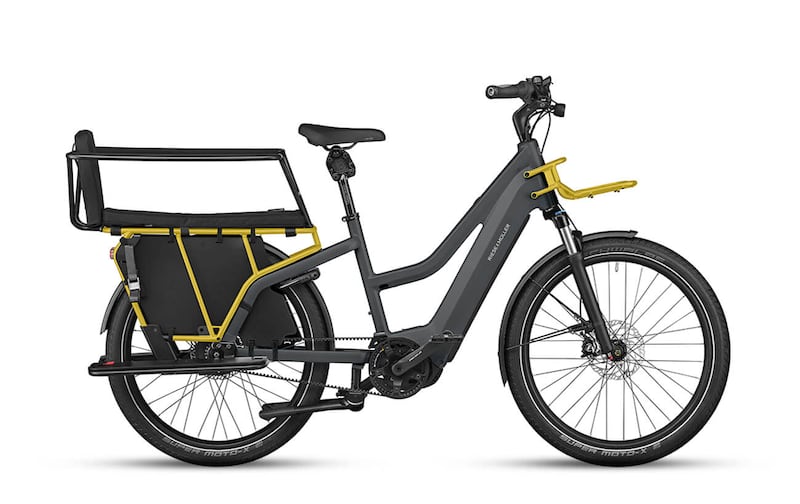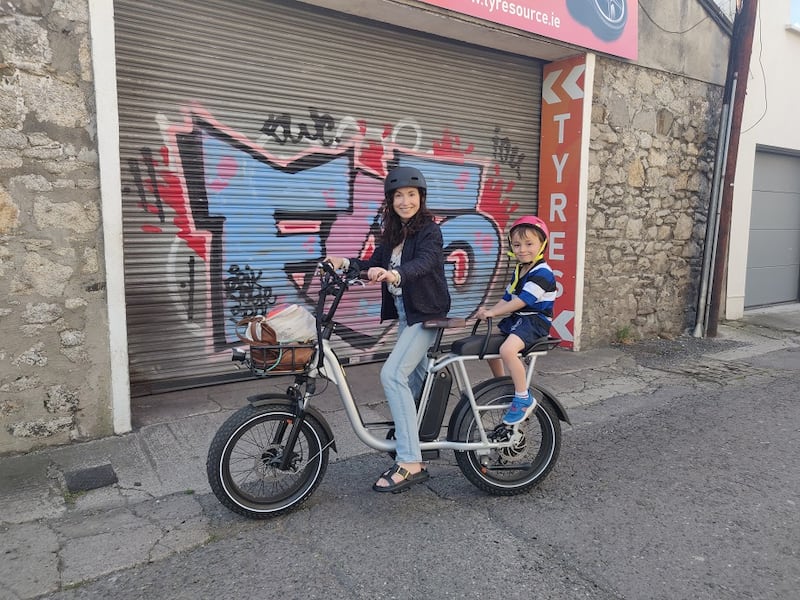Before we got an electric bike I wrongly assumed they would be tricky and were only for very confident cyclists.
When we finally invested last year it was not an impulse buy.
My partner had been watching the e-bike market for years and I became convinced when I saw how well the in-laws in France got on with theirs. We were quite specific – we wanted a utility, or city, bike that felt substantial with a seat on the back for a child.
In 2018 we had splashed out on a Workcycle FR8 bike from the Dutch bike shop (they have since moved to Navan where you can visit their yard), which allowed us to ferry the kids around, but they were bigger now and heavier, and we felt if we had a bike with a motor we might use the car less.
After much research online we settled on a RadRunner Plus.
This is from an American company and was voted the number one for reliability and price from a brilliant e-bike guru type called Ryan Johnson.
They don't have any stores in Ireland. There is one in Utrecht, so all of our purchases were made online.
Demand soared for e-bikes during Covid and this model was sold out for most of 2021 so when it became available last November we were ready and she arrived one month later. Ideally, we would have got one each but they are a big investment.
I had also looked at the VanMoof, a trendy looking bike from the Netherlands, which would have been more of a "niparound". If my kids were younger, and I was richer, I would invest in an electric "bakfiet" – box bike in Dutch.
The Rothar bike shop in Phibsboro in Dublin's northside has the Belgium made Achielle Ferre in stock, with the box in front, and another cargo option, the Italian made Bicicapace, which has a long tail for kids to go on the back. Owner Anne Bedos says they will take 6-8 weeks and 3-4 months respectively to arrive.
Manoeuvring the bike to work scheme
My partner would be using the bike to travel to work meetings – I would also do this as what stopped me cycling to work meetings before was the fear of arriving sweaty-betty style – so we bought it on the bike to work scheme.
The limit is €1,500 and as ours cost €1,799, with no add ons, it was a little complicated.
I work freelance and because my partner works for a smaller employer they had no experience of the scheme. However, with help from the company’s accountant they were able to work it so he was eligible.
Also, it turned out Rad Runner had some experience with the scheme.
We contacted a salesperson who helped us separate the cost into two invoices, the €1,500 one was paid by my partner’s employer – he repays them over a year (the maximum time). This is pre-tax so we save 40 per cent, and we paid the €450 balance.
This included our add ons – a seat and passenger bars, a carrier on the front for luggage and a phone holder.

Assembly time
If you buy on the internet you have to, to some extent, put the e-bike together yourself. Whereas if you buy from a shop they will do this for you, as well as offer advice and check-ups.
It arrived in one huge box 85 per cent assembled; we needed to put on the front wheel, handle bars and fenders.
The tools were included and the electric bits you might be anxious about were complete.
My partner loves tinkering with bolts so he happily put it together in 2½ hours. There are links to two very precise videos to follow.
There is a charger that comes with it which plugs into the wall and you can take the battery off and plug it in directly.
We charge it once a week. This takes four hours to give about a 70km range.
Zooming around
I was a bit scared at first, only cycling around the block, but, essentially, if you can cycle you can ride an e-bike.
There are five levels of pedal assist and level two is the speed I feel most comfortable with.
Research shows you still get your heart rate up, but it’s a very pleasant experience, especially gliding up hills. There is a small clicker called “the throttle” which you nudge and this gives you a boost when setting off. The tires are wide enough to go over potholes but compact so you can nip around easily.
I feel nervous leaving it anywhere. I’ve noticed more car parks have spaces for electric bikes – such as Drury Street car park in Dublin – but this is not widespread yet.
At 65lb it is difficult to cycle without the motor on, so you really don’t want to run out of power.
There is a display box that tells you how many kilometres you have, but my partner did get stranded in Dún Laoghaire 9km away and had to be saved with the car.
On any bike I am nervous in busy traffic, or of people stepping out, so I have ordered a Loud Bicycle horn, which sounds like a car.

Fuel economy
Electric bikes cost almost nothing to run: 5 cents to charge for 80km.
We are getting great use – on average 40km a week. Last week it was used for work meetings, to return library books, to drop our son at football practice and to his weekend match 10km away, and one night we went out for dinner and I sat on the back.
A litre of petrol costs €1.90 and covers about 12.4km, so that’s about €7 weekly we save on fuel and there is no parking fee.
Any savings are very welcome these days and the e-bike has really made us consider our car use.
When I replace a car journey now I do feel a bit smug with my drastically lower carbon footprint.
You can use the bike to work scheme every four years so we will definitely get another one then.




